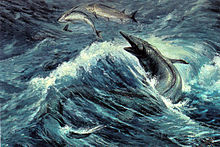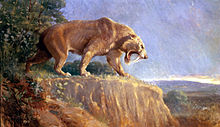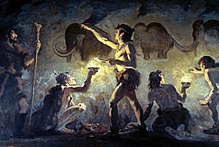From Wikipedia, the free encyclopedia
| Charles R. Knight | |
|---|---|

Photo from ca. 1914
|
|
| Born | October 2, 1874 Brooklyn, New York |
| Died | April 15, 1953 (aged 78) Manhattan, New York |
| Nationality | American |
| Field | Painting |
Contents
Biography
Early life
As a child, Knight was deeply interested in nature and animals, and spent many hours copying the illustrations from his father’s natural history books. Though legally blind because of astigmatism and a subsequent injury to his right eye, Knight pursued his artistic talents with the help of specially-designed glasses, and at the age of twelve, he enrolled at the Metropolitan Art School to become a commercial artist. In 1890, he was hired by a church-decorating firm to design stained-glass windows, and after two years with them, became a freelance illustrator for books and magazines, specializing in nature scenes.
Entelodon (then known as Elotherium), the first commissioned restoration of an extinct animal by Charles R. Knight[1]
One of Knight's best-known pieces for the American Museum of Natural History is 1897’s Leaping Laelaps, which was one of the few pre-1960s images to present dinosaurs as active, fast-moving creatures (thus anticipating the "Dinosaur Renaissance" theories of modern paleontologists like Robert Bakker). Other familiar American Museum paintings include Knight’s portrayals of Agathaumas, Allosaurus, Brontosaurus, Smilodon, and the Woolly Mammoth. All of these have been reproduced in numerous places and have inspired many imitations.
Knight’s work for the museum was not without critics, however: many curators argued that his work was more artistic than scientific, and protested that he did not have sufficient scientific expertise to render prehistoric animals as precisely as he did. While Knight himself agreed with that his murals for the Hall of the Age of Man were “primarily a work of art,” he insisted that he had as much paleontological knowledge as the museum’s own curators.[2]
Nationwide attention
After Knight established a reputation at the American Museum of Natural History, other natural history museums began requesting paintings for their own fossil exhibits. In 1925, for example, Knight produced an elaborate mural for the Natural History Museum of Los Angeles County which portrayed some of the birds and mammals whose remains had been found in the nearby La Brea Tar Pits. The following year, Knight began a 28-mural series for Chicago’s Field Museum of Natural History, a project which chronicled the history of life on earth and took four years to complete. At the Field Museum, he produced one of his best-known pieces, a mural featuring Tyrannosaurus and Triceratops. This confrontation scene between a predator and its prey would inspire a huge number of imitations, establishing the two dinosaurs as “mortal enemies” in the popular consciousness. The Field Museum’s Alexander Sherman says, “It is so well-loved that it has become the standard encounter for portraying the age of dinosaurs”.[3]While making murals for museums and zoos, Knight continued illustrating books and magazines, and became a frequent contributor to National Geographic. He also wrote and illustrated several books of his own, such as Before the Dawn of History (Knight, 1935), Life Through the Ages (1946), Animal Drawing: Anatomy and Action for Artists (1947), and Prehistoric Man: The Great Adventure (1949). Additionally, Knight became a popular lecturer, describing prehistoric life to audiences across the country.
Eventually, Knight began to retire from the public sphere to spend more time with his grandchildren, who shared his passion for animals and prehistoric life. In 1951, he painted his last work, a mural for the Everhart Museum in Scranton, Pennsylvania. Two years later, he died peacefully in Manhattan.
Legacy
Knight has been hailed as "one of the great popularizers of the prehistoric past", and as having influenced generations of museum-goers.[5] Examples of Knight's work frequently appeared in dinosaur books published in the US during the first half of the twentieth century.[6] Many works released since then also include examples of Knight’s paintings; for example, Stephen Jay Gould used one of Knight’s paintings for the cover of his 1991 book Bully for Brontosaurus and another in his 1996 book Dinosaur in a Haystack. Though many other paleoartists have succeeded Knight (most notably Zdeněk Burian) Knight’s paintings still remain very popular among paleontology enthusiasts. A commemorative edition of Knight’s 1946 book Life Through the Ages [ISBN 0-253-33928-6] was recently published by Indiana University Press, and a 2007 calendar [ISBN 0-7649-3622-0] of Knight’s paintings is also currently available. Additionally, fantasy artist William Stout has compiled a series of Charles Knight Sketchbooks, which contain many rare and previously unpublished drawings and studies by Knight.
Knight's restoration of Agathaumas from 1897, which was later used as basis for a model Agathaumas used in the 1925 film The Lost World.[7]
The late Stephen Jay Gould was one of Knight’s most well-known fans, notably refusing to refer to Brontosaurus as “Apatosaurus” because Knight had always referred to the creature with the former name.[4] Gould writes in his 1989 book Wonderful Life, “Not since the Lord himself showed his stuff to Ezekiel in the valley of dry bones had anyone shown such grace and skill in the reconstruction of animals from disarticulated skeletons. Charles R. Knight, the most celebrated of artists in the reanimation of fossils, painted all the canonical figures of dinosaurs that fire our fear and imagination to this day”.[8] Other admirers have included special effects artist Ray Harryhausen, who writes in his autobiography An Animated Life, “Long before Obie (Willis O'Brien), myself, and Steven Spielberg, he put flesh on creatures that no human had ever seen. […] At the L.A. County Museum I vividly remember a beautiful Knight mural on one of the walls depicting the way the tar pits would have looked in ancient times. This, plus a picture book about Knight’s work my mother gave me, were my first encounters with a man who was to prove an enormous help when the time came for me to make three-dimensional models of these extinct beings”.[8] Paleoartist Gregory S. Paul has also mentioned Knight as a big influence on him.[9][10]
In 2012 a book about Knight and his art written by Richard Milner titled Charles R. Knight The Artist Who Saw Through Time was published.[11]
An homage to the painter was also made in the IMAX feature film, T-Rex: Back to the Cretaceous, in which he was portrayed by actor Tuck Milligan.
Works

Mural at the AMNH, showing the fauna of the La Brea Tar Pits. This image was adapted as the cover illustration for the book The Mythical Man-Month.

Bison on the 1901 United States ten-dollar bill, drawn by Knight

Tylosaurus from 1899
- Academy of Natural Sciences (Philadelphia, Pennsylvania)
- American Museum of Natural History (New York, New York)
- Bethune-Cookman College (Daytona Beach, Florida)
- Bronx Zoo (Bronx, New York)
- Carnegie Museum of Natural History (Pittsburgh, Pennsylvania)
- The Dinosaur Museum (Blanding, Utah)
- Everhart Museum (Scranton, Pennsylvania)
- Field Museum of Natural History (Chicago, Illinois)
- Florida Museum of Natural History (Gainesville, Florida)
- Illinois State Museum (Springfield, Illinois)
- Mesa Southwest Museum (Mesa, Arizona)
- Museum of the Earth (Ithaca, New York)
- National Museum of Natural History (Washington, DC)
- National Zoo (Washington, DC)
- Natural History Museum of Los Angeles County (Los Angeles, California)
- Princeton University (Princeton, New Jersey)
- Science Museum of Minnesota (Saint Paul, Minnesota)
- Sebring Public Library (Sebring, Florida)
- Yale Peabody Museum of Natural History (New Haven, Connecticut)
Publications
- Before the Dawn of History, 1935
- Life Through the Ages, 1946
- Animal Drawing: Anatomy and Action for Artists, 1947
- Prehistoric Man: The Great Adventure, 1949
- Charles R. Knight, Autobiography of an Artist, 2005







No comments:
Post a Comment